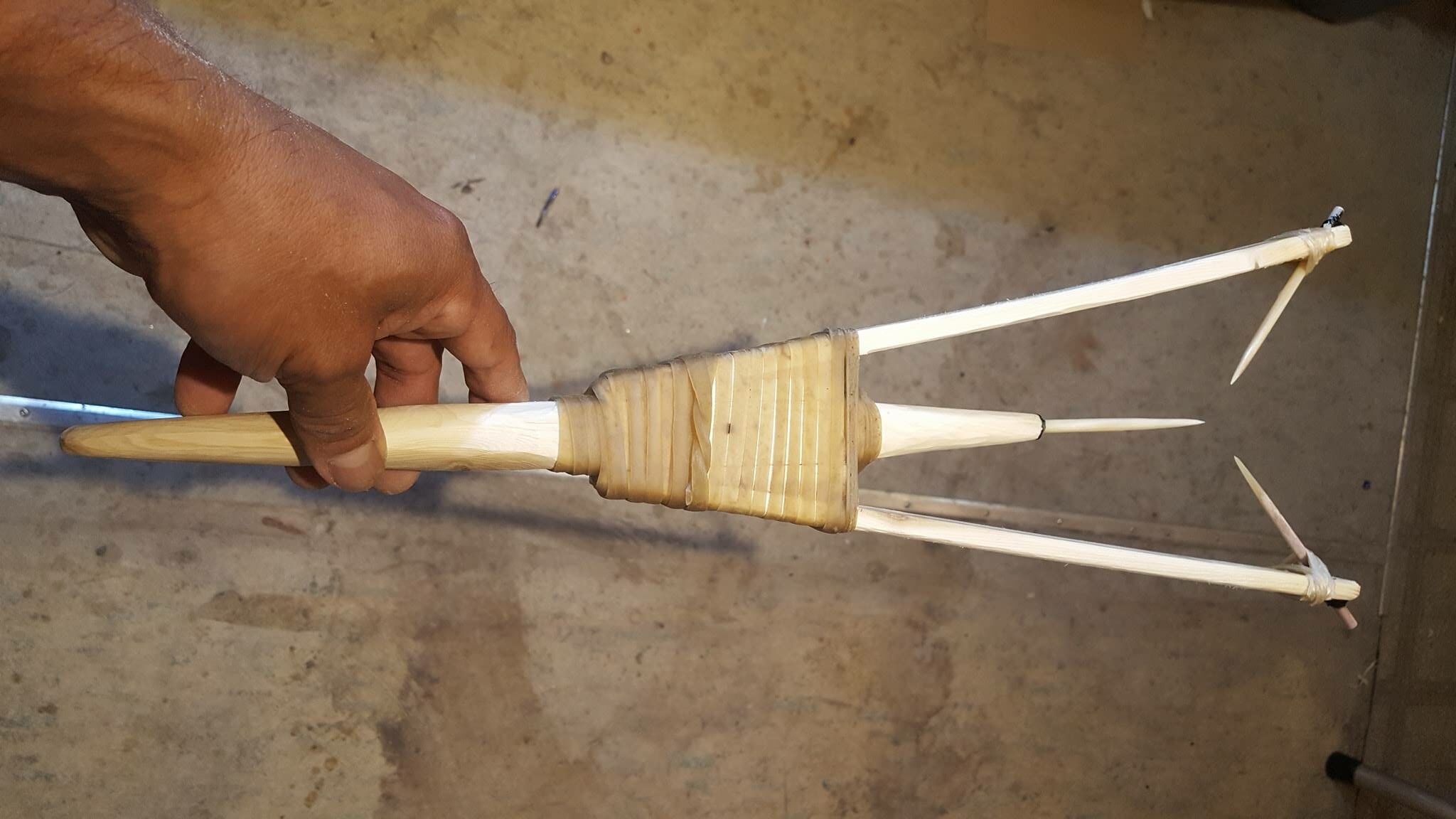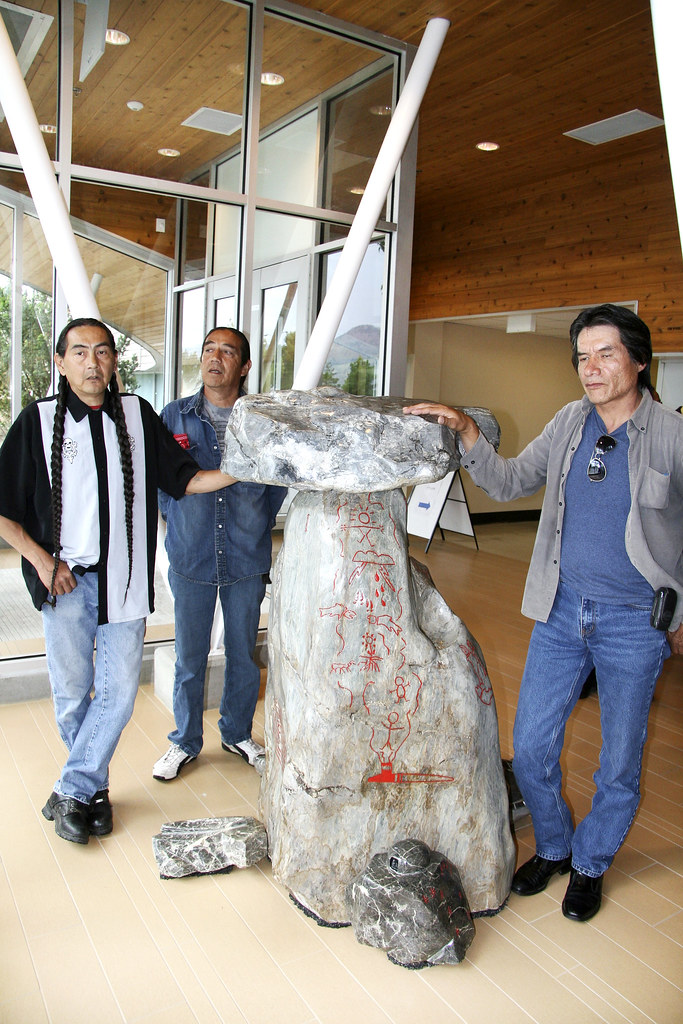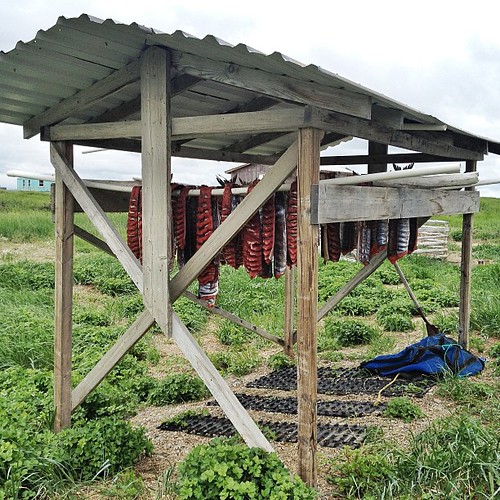5 Secwepemcúl’ecw

“Traditional cedar and elk bone fishing spear” by Ed Jensen is in the Public Domain. Used with permission.
Although TRU is located on the traditional lands of Tk’emlúps te Secwépemc, the immediate area takes up a portion of the 180,000km2 area of Secwpemcúl’ecw. While Kamloops has been coined as the meeting of the waters, the waters connect multiple communities as the original highway system. The short arm of the South Thompson River is a drainage from Little Shuswap Lake near Adams Lake. Sources for this flow come from an intricate runoff of rivers, lakes and streams. The North Thompson River is fed from the toe of the Thompson Glacier near Valemount and is the largest tributary of the Fraser River with the confluence in the neighbouring Nlaka’pamux Nation in Lytton. Traveling straight through Secwepemcúl’ecw is the Fraser River, which is the longest river in British Columbia. It is fed from snowmelt from the Rocky Mountain range of Northern British Columbia. Secwépemc communities came together on June 22, 2012 to execute the Unity Declaration, which begins:
We have lived in our homelands the Secwepemcúlecw, for so long that the time of occupation extends beyond the reach of memory.
Our Secwepemc Nation originally consisted of thirty-two communities separate and independent of one another, but united by a common language, customs, ceremonies and traditions. Each community consisted of a village or a small cluster of villages with each community having several leaders, each with a different responsibility. Seventeen communities representing all Secwepemc people exist today within a 180,000 square kilometre [sic] traditional territory.[1]
The boundaries of the Secwépemc Nation have been disputed amongst the local Indigenous groups over time. In order to settle territorial boundaries, the stseptékwll[2] tell the stories about how one territory ends and the next begins.[3] These stories are often visualized by the natural environment. For the Secwépemc Nation, these markers have manifested in the form of pillars of rock that stand seemingly unnaturally in the landscape. A territorial marker exists north of present-day Falkland, separating the Secwépemc and Syilx Nations. Another exists off the south shore of Kamloops Lake between present-day Kamloops and Savona. Existence of these territorial markers was acknowledged in the “Memorial to Sir Wilfrid Laurier”:
When they first came among us there were only Indians here. They found the people of each tribe supreme in their own territory, and having tribal boundaries known and recognized by all. (emphasis added)[4]
Upholding their partnership with Tk’emlúps te Secwépemc, and with dedicated advocacy from the Indigenous Law Students’ Association (“ILSA”), Thompson Rivers University commissioned a territorial marker which is located at the bottom of the elevator of TRU Law in Old Main.

“Aboriginal Territorial Marker” by Thompson Rivers is licensed under CC BY-NC-SA 2.0

“TK 208” by KORTE IMAGING is licensed under CC BY-NC-ND 2.0
Each year Secwépemc communities would flock to the riverside to catch fresh salmon to feed their families for the year. DNA samples taken from skeletal remains of an elderly female dating some 5,000 years old in the Clinton area, it was determined that their diet consisted of about 24-36% marine protein.[5] The canyon landscape of the Fraser River as it winds through the Cascade Mountains continues to provide an environment perfect for wind-dried salmon where the meat is filleted with the skin intact, scored, and hung to dry in the arid heat.

“drying salmon. skin-side towards the wind for the first few days, then switched.” by cowboycoffee is licensed under CC BY-NC-ND 2.0
Various fishing methods were developed over time. These methods provide Secwépemc Peoples with selective fishing practices that allow for fisheries management. Salmon were harvested from hard-to-reach waters by dip-net, gaff, or spears utilizing peeled wood poles with sharp tools whittled out of animal bones and tied with natural hemp. Calmer waters were fished utilizing weir fences, pitch lamp canoe, and basket traps amongst others. By seeing the fish up close that are being targeted, Secwépemc fishers identify the sex, remove a proportionate number of salmon present, and contribute to sustaining management for years to come. This first-hand fishing approach is very different than commercial fishing practices that take place on the ocean where nets are cast and whatever is lurking under the surface is collected.
Salmon spawn in the tributaries of the Fraser and Thompson River watersheds and return to the Pacific Ocean for four years before returning to spawn. Over time the salmon return has been declining, with one major salmon return cycle remaining—every four years. The decline has been described as follows:
It was not until the 1960s and 1970s that the use of Aboriginal resources began to decline severely, in part due to the decline of knowledge transfer caused by generations of residential school attendance and by the increasing reliance both on wage labour and on market foods. In addition, salmon runs continued to dwindle, and the federal Department of Fisheries and Oceans increased its regulatory power.[6]
CBC News: The National – Sockeye salmon return in B.C.’s Adams River – Oct. 15, 2018
Managing fisheries is a difficult issue. With the water outflow of these major tributaries, along with the Columbia watershed in south-eastern Secwepemcúl’ecw, Federal departments take the lead. Under the governance structure of the Shuswap Nation Tribal Council, the Secwepemc Fisheries Commission operates by asserting and advocating for fishing rights for the lower Secwepemc communities. Struggles continue to exist between First Nations fisheries (food, social and ceremonial), sport fishing, and commercial fishing activities. First Nations continue to struggle with proving their need. To capture “need” for fisheries, First Nations communities are challenged to come up with a number each year for how many fish their community will need to sustain themselves. While this appears to be a very linear solution to sharing a resource, it is often difficult for First Nations communities to estimate unforeseen circumstances such as number of deaths in their respective communities where fresh salmon is a staple for ceremonial feasts. Further, it is also difficult to establish a trusting relationship when First Nations communities have witnessed their fishing numbers decease steadily. What most Canadians do not realize, is that the Department of Fisheries and Oceans stipulates openings for First Nations fisheries to take place. Some communities have openings for as little as 5 days per year where they are fined for fishing out of those openings without prior permission. This poses difficulties if a community member passes away and despite knowing that fresh fish is part of needed for the ceremonial feast, they are told to wait and seek permission before removing fish from the water. Individuals often do not report the number of fish they catch for their families each year for fear of boxing themselves into a number. Many things have been forcibly removed from Indigenous control and regulation, resulting in minimal trust. Secwepemc Fisheries Commission advocates and asserts fishing rights for Secwépemc fisheries by receiving guidance from their Steering Committee, consisting of representation from each of the member bands. Additionally, biologists and technicians from the Secwepemc Fisheries Commission engage with communities by supporting restoration projects, cultural education in the local school districts, and financial management disbursements.
- "Secwepemc Nation Unity Declaration" (22 June 2012), online (pdf): Shuswap Nation Tribal Council <shuswapnation.org/files/2018/06/39.-Secwepemc-Nation-Unity-Declaration-June-22-2012.pdf> [perma.cc/9P5X-SZNN]. ↵
- null ↵
- see Marianne Ignace & Ronald E. Ignace, “Chapter 7 Re Stslexemúĺecwems-kucw Secwépemc Sense of Place” Secwépemc People, Land, and Laws Yerí7 re Stsq’ey’s-kucw (Toronto: McGill-Queen’s University Press, 218) at 12: “Through past and present Secwépemc elders’ stories – both stsptekwll (oral traditions), which are ancient, handed-down narratives, or “stories,”, from the past, and slexéýem (oral histories), which are personally experienced or handed-down memories of lived experience – we thus present the coming-into-being of Secwepemcúĺecw as a process of history, not as a once-and-for-all accomplished, immutable event.” ↵
- Shuswap Nation Tribal Council, “The Memorial to Sir Wilfrid Laurier: Commemorating the 100th Anniversary, 1910-2010” (2010), online (pdf): Shuswap Nation Tribal Council <shuswapnation.org/files/2012/09/137543_ShuswapNation_MemorialBro.pdf> [perma.cc/2H3N-YY9E]. ↵
- Marianne Ignace & Ronald E. Ignace, “Chapter 7 Re Stslexemúĺecwems-kucw Secwépemc Sense of Place” Secwépemc People, Land, and Laws Yerí7 re Stsq’ey’s-kucw (Toronto: McGill-Queen’s University Press, 218) at 39. ↵
- Marianne Ignace & Ronald E. Ignace, “Chapter 7 Re Stslexemúĺecwems-kucw Secwépemc Sense of Place” Secwépemc People, Land, and Laws Yerí7 re Stsq’ey’s-kucw (Toronto: McGill-Queen’s University Press, 218) at 219. ↵
ancient stories, oral traditions, legends.
